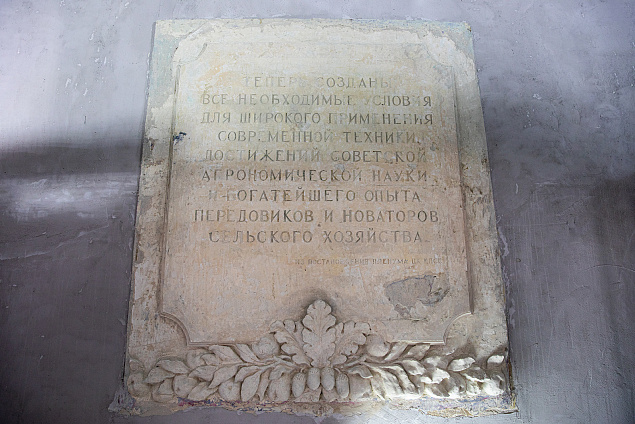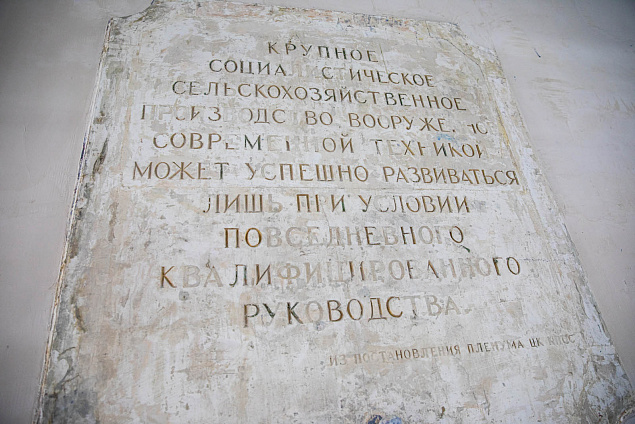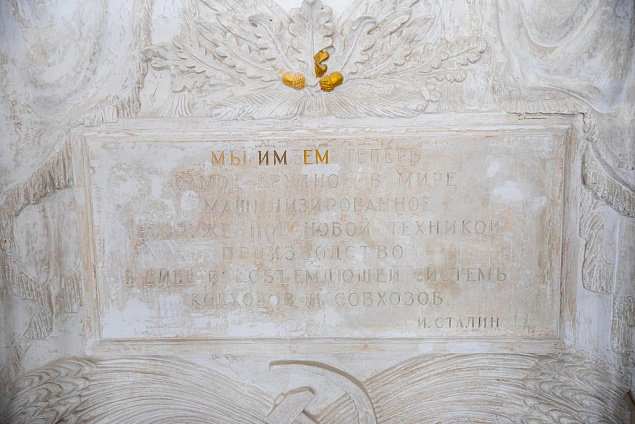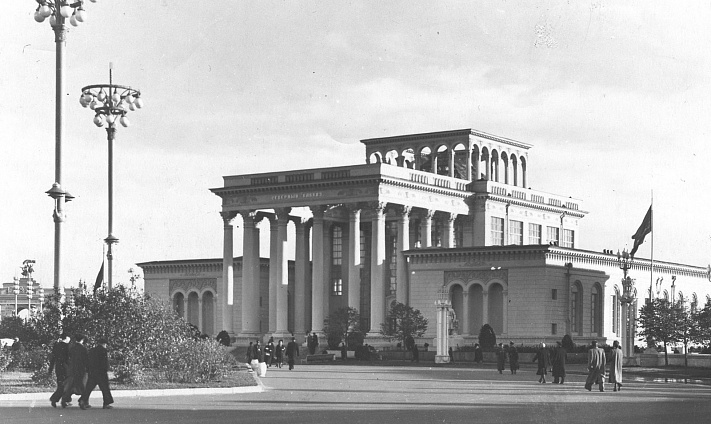During the interior renovations in Pavilion No. 2 'Education', the experts revealed three ornamental inscriptions after removing a layer of plaster. The inscriptions used to be part of the pavilion's decor during the 20th century. These valuable finds will be restored to match the historical interior finishings of the 1950s.
All three inscriptions are relevant to agriculture. For reference: this pavilion was built in 1954 and was originally named 'North Caucasus'; its exposition at the time showcased the region's achievements in agriculture.
Two of the historical inscriptions were uncovered in one of the pavilion's side rooms. They are part of ornamental bas-reliefs over the doorways, which have not survived. The bas-reliefs once pictured banners with heraldic shields and figures of a young man and woman, meant to symbolise rural workers and standing on either side of the inscription plaques; the latter have been preserved to this day. Both inscriptions quote a decree adopted at a plenary session of the Communist Party's Central Committee. The first inscription says, 'Now we have created all the necessary conditions for the widespread application of modern technology, the achievements of the Soviet agronomic science and the wealth of experience accumulated by agriculture's best workers and innovators'. The other inscription says, 'Large-scale socialist agricultural production, armed with modern technology, can only succeed under qualified daily management'.
The restoration team's third discovery is a cartouche over the doorway. The inscription in the cartouche is a quote from Joseph Stalin, "We now have the world's largest mechanised production system, equipped with the latest tools and embodied by an extensive network of kolkhoz and sovkhoz farms".
The letters are coated in gold. The technical expert has collected some samples of the paint, allowing the team to determine that it's imitation gilding. Right now, the team is researching an optimal restoration technology, under designer supervision. All letters will be restored to accurately represent the historical finish: imitation gilding of choice. Work to restore the cartouche itself is ongoing as well.
The team unearthed the inscriptions as carefully and meticulously as possible, removing layer after layer of later additions. During the cleanup, the experts fought for every letter, striving to reveal the entire inscription without causing any damage.
This is just one stage of the large-scale restoration project that is currently in progress in the 'Education' pavilion. The experts have already cleaned up the greenhouse, restoring and returning the original white and light-grey marble slabs that used to line the floor. The wall adjacent to the southern hall has been repainted, the metal structures in the greenhouse have undergone anti-corrosion treatment and the lost glass elements have been recreated.
Furthermore, the experts are removing later paint layers, cleaning up and restoring the metal window frames in the side wings, the greenhouse and the southern and central halls. They will later be repainted to match the rediscovered original palettes.
The surviving historical windows and doors, as well as walls and ceilings, are also being renovated by the experts, who are painstakingly reproducing the original paint finish and stucco. Furthermore, they are cleaning up the flooring, which is made out of marble plates and breccia with various patterns, laid down both during the pavilion's original construction and the subsequent restoration at different points in history.
We should note these are far from the only discoveries made at VDNH during pavilion renovation. In fact, more than two dozen valuable historical artefacts have been unearthed throughout the Exhibition. Some of the most notable ones include: spare tempered glass blocks, discovered in a basement room underneath Pavilion No. 62 'Nature Protection'; Soviet republics' coats of arms that had been tucked away under the dome of Pavilion No. 34 'Space'; and bas-reliefs depicting farm work in the Kazakh SSR, dating back to 1954 and found on the facade of Pavilion No. 11 'Republic of Kazakhstan'.



